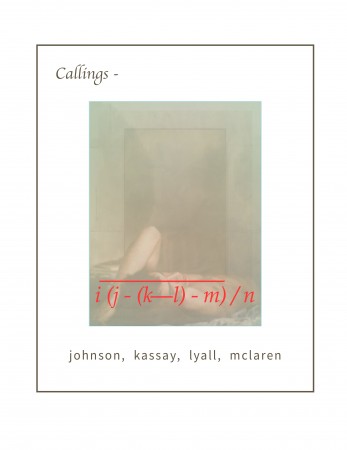xxxxxi ( j - (k — l) - m ) / n
_____
20 October to 26 November 2022

Start by noting the two-part title. One part, “Callings,” presents a word that supports a variety of different meanings. One is an algorithmic model. These can be read as two half-sayings that, combined, don’t make for a single statement. “Callings” makes knots of verbal reference. The model, by contrast, consists of symbols—or, letters that do not result in words. At least, they do not reach out for words until a good diagram is assembled for them. Both of the parts are made of letters, but their partial status leaves a space for play between the seeable and its sayability. Scott Lyall calls this gap the EPISCENE.
— a set (k—l) includes three elements: the letters (k) and (l), plus a DASH between them. The DASH is a logically empty surface that holds the space of a missing term. It is both a bond and a distance-keeper. “A flower is missing from every bouquet.”
— the set (k—l) lies bracketed between two further letters, (j -), and (- m). These appear with dashes, too, but each measures only half the DASH. This means that (j -) and (- m) relate to the space that is structured by the set, (k—l). Thus, (k—l) is a mediator, while (j -) and (- m) are dual contexts.
— under (k—l) there is no relationship. We detect no necessary (standard) bond that would link both (j -) and (- m) in unison. (k—l) ADDS to this non-relation. It doesn’t over-write what was there before. Rather, as a kind of insert-edit, it adds a potential to create montage. (k—l) brings forth sequence, syntax, frame, assembly, registration, refraction. It does it in an almost filmic way.
— the letter (i) is a signifier. It multiplies the set (j - (k—l) - m) by ONE to produce its situation and, as such, to render a discursive scene.
— i (j- (k—l) -m) is joined by a vinculum (the horizontal bar that appears above the letters to mark their scene.) This is divided by (n) : “non-(i).” The scene turns into a dividend. But “non-(i)” represents infinity. Thus, with (n), the finite scene absorbs an infinitely surplus part. Again, partitioning implies montage, but the surplus circulates to glue each element within the scene to its own non-finitude.
Tracing interactions between its titles, the show lays out a diagram of works by Scott Lyall, Jacob Kassay, A Johnson, Norman McLaren, and anonymous. Relationships are modelled, implied, or blurred. Together they allow for a playful thinking of milieus and solitudes, bodies, metiers, material cultures, “languages of technical exposure,” partitions, and mutual summonings. Every letter is an open Call.

